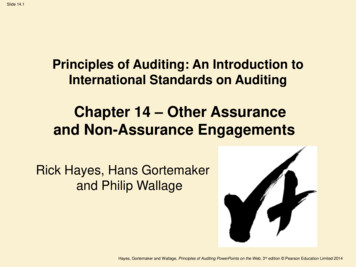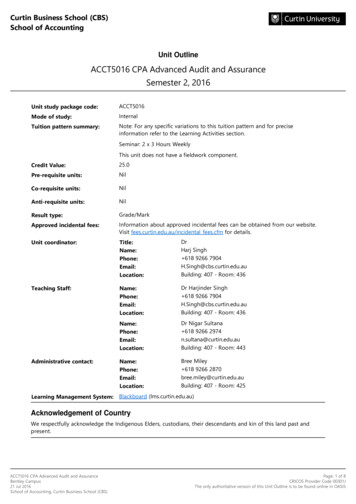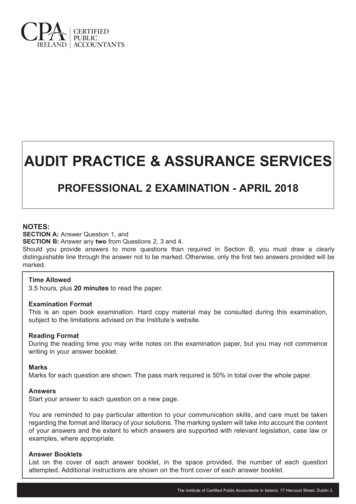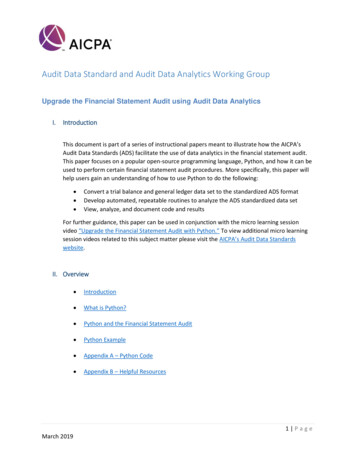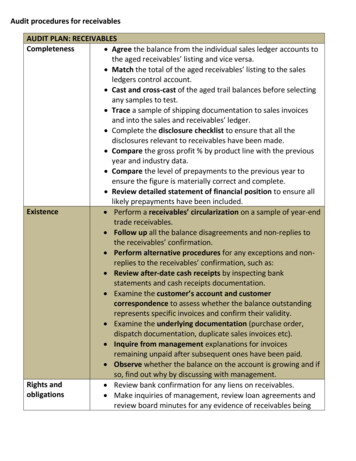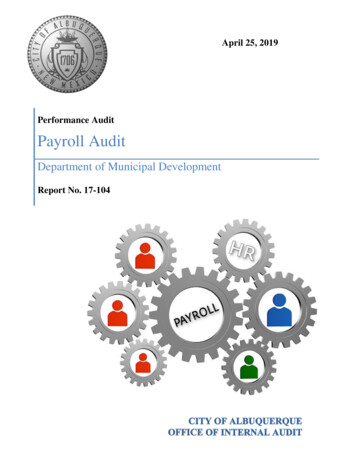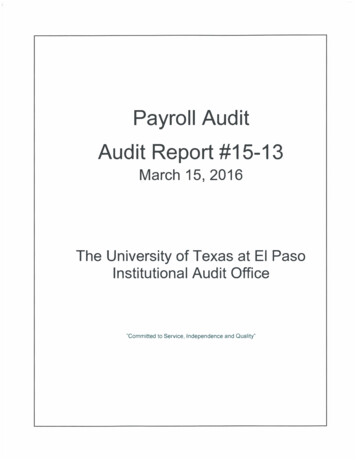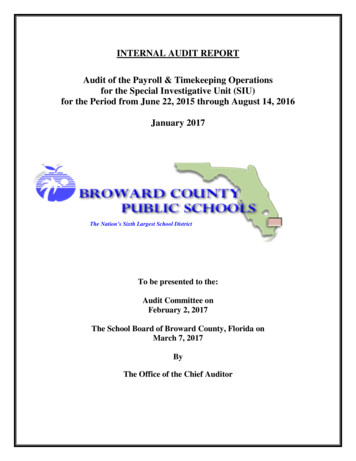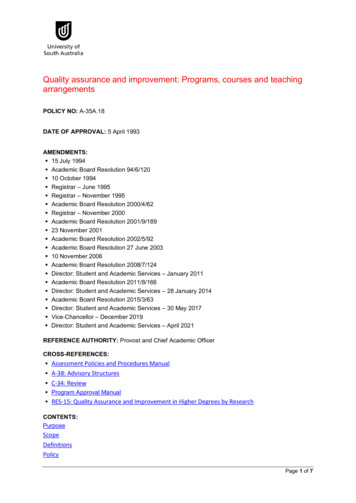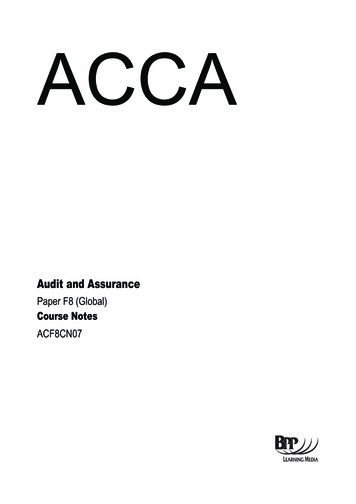
Transcription
Audit and AssurancePaper F8 (Global)Course NotesACF8CN07
l
F8 Audit and Assurance (Global)Study ProgrammePageIntroduction to the paper and the course. (ii)123456The concept of audit and other assurance engagements . 1.1Statutory audits . 2.1The regulatory environment and corporate governance. 3.1Professional ethics and ACCA's Code of Ethics and Conduct . 4.1Internal audit. 5.1Risk assessment . 6.1End of Day 1 – refer to Course Companion for7891011Home StudyProgress test 1Audit planning and documentation . 7.1Introduction to audit evidence. 8.1Internal control. 9.1Tests of controls . 10.1Audit procedures and sampling. 11.1End of Day 2 – refer to Course Companion forHome StudyProgress test 2Course exam 11213141516171819Receivables. 12.1Inventory. 13.1Liabilities and capital . 14.1Bank and cash. 15.1Non-current assets . 16.1Not–for-profit organisations . 17.1Audit review and finalisation. 18.1Reports. 19.1End of Day 3 – refer to Course Companion forHome StudyProgress test 3Course exam 2202122Answers to Lecture Examples . 20.1Question and Answer bank . 21.1Appendix: Pilot Paper questions (UK and International) . 22.1Don’t forget to plan your revision phase! Revision of syllabusTesting of knowledgeQuestion practiceExam technique practiceBPP provides revision courses, question days,mock days and specific material to assist you inthis important phase of your studies.(i)
INTRODUCTIONIntroduction to Paper F8 Audit and AssuranceOverall aim of the syllabusTo develop knowledge and understanding of the process of carrying out the assurance engagement and itsapplication in the context of the professional regulatory framework.The syllabusThe broad syllabus headings are:ABCDEFGAudit framework and regulationInternal auditPlanning and risk assessmentInternal controlAudit evidenceReviewReportingMain capabilitiesOn successful completion of this paper, candidates should be able to: Explain the nature, purpose and scope of assurance engagements including the role of the external auditand its regulatory and ethical framework. Explain the nature of internal audit and describe its role as part of overall performance management andits relationship with the external audit Demonstrate how the auditor obtains an understanding of the entity and its environment, assesses therisk of material misstatement (whether arising from fraud or other irregularities) and plans an audit offinancial statements Describe and evaluate information systems and internal controls to identify and communicate control risksand their potential consequences, making appropriate recommendations Identify and describe the work and evidence required to meet the objectives of audit engagements andthe application of the International Standards on Auditing Evaluate findings and modify the audit plan as necessary Explain how the conclusions from audit work are reflected in different types of audit report, explain theelements of each type of reportLinks with other papersThe Professional Accountant(P1)Corporate andBusiness Law (F4)Financial Reporting(F7)Advanced Audit and Assurance(P7)Audit & Assurance(F8)This diagram shows where direct (solid line arrows) and indirect (dashed line arrows) links exist between thispaper and other papers that may precede or follow it.Although ACCA's diagram shows Paper F7 feeding into Paper F8, the accounting knowledge assumed in the F8exam will only be that covered within Paper F3 Financial Accounting.(ii)
INTRODUCTIONAssessment methods and format of the examExaminer: Alan LewinThe examination is a three hour paper with 15 minutes reading and planning time. All questions are compulsory.Some questions will adopt a scenario/case study approach. All questions will require some form of writtenresponse although questions on planning or review may require the calculation and interpretation of some basicratios.Format of the ExamMarksQuestion 1This will always be a question on audit procedures, and the application ofthese procedures to a specific scenario30Question 2Short factual questions based on International Standards on Auditing (ISAs)and other knowledge-based areas of the Study Guide10Question 3These questions are likely to involve short practical scenarios and will covertopics such as: internal audit, risk assessment, planning, controls, evidence,conclusions and reporting20Question 4Question 52020100(iii)
INTRODUCTIONCourse AimsAchieving ACCA's Study Guide OutcomesAAudit framework and regulationA1 The concept of audit and other assurance engagementsChapter 1A2 Statutory auditsChapter 2A3 The regulatory environment and corporate governanceChapter 3A4 Professional ethics and ACCA's Code of Ethics and ConductChapter 4BInternal auditB1 Internal audit and corporate governanceChapter 5B2 Differences between external and internal auditChapter 5B3 The scope of the internal audit departmentChapter 5B4 Outsourcing the internal audit departmentChapter 5B5 Internal audit assignmentsChapter 5CPlanning and risk assessmentC1 Objective and general principlesChapter 6C2 Understanding the entity and knowledge of the businessChapter 6C3 Assessing the risks of material misstatement and fraudChapter 6C4 Analytical proceduresChapter 6C5 Planning an auditChapter 7C6 Audit documentationChapter 7C7 The work of othersChapter 11DInternal controlD1 Internal control systemsChapter 9D2 The use of internal control systems by auditorsChapter 9D3 Transaction cyclesChapter 9D4 Tests of controlChapter 10D5 The evaluation of internal control componentsChapter 10D6 Communication on internal controlChapter 10(iv)
INTRODUCTIONEAudit evidenceE1The use of assertions by auditorsChapter 8E2Audit proceduresChapter 11E3The audit of specific itemsE4Audit sampling and other means of testingChapter 11E5Computer-assisted audit techniquesChapter 11E6Not-for-profit organisationsChapter 17FReviewF1Subsequent eventsChapter 18F2Going concernChapter 18F3Management representationsChapter 18F4Audit finalisation and the final reviewChapter 18GReportingChapters 12-16G1 Audit reportsChapter 19G2 Reports to managementChapter 10G3 Internal audit reportsChapter 5(v)
INTRODUCTIONClassroom tuition and Home studyYour studies for BPP consist of two elements, classroom tuition and home study.Classroom tuitionIn class we aim to cover the key areas of the syllabus. To ensure examination success you will need to spendprivate study time reinforcing your classroom course with question practice and reviewing areas of the CourseNotes and Study Text.Home studyTo support you with your private study BPP provides you with a Course Companion which helps you to work athome and aims to ensure your private study time is effectively used. The Course Companion includes a HomeStudy section which breaks down your home study by days, one to be covered at the end of each day of thecourse. You will find clear guidance as to the time to spend on various activities and their importance.You are also provided with progress tests and two course exams which should be submitted for marking as theybecome due.These may include questions on topics covered in class and home study.BPP Learn OnlineCome and visit the BPP Learn Online free at www.bpp.com/acca/learnonline for exam tips, FAQs and syllabushealth check.ACCA ForumWe have thriving ACCA bulletin boards at www.bpp.com/accaforum. Register and discuss your studies withtutors and students.HelplineIf you have any queries during your private study simply contact your class tutor on the telephone number ore-mail address that they will supply. Alternatively, call 44 (0)20 8740 2222 (or your local training centre ifoutside the London area) and ask for a tutor for this paper to speak to you or to call you back within 24 hours.FeedbackThe success of BPP’s courses has been built on what you, the students tell us. At the end of the course for eachsubject, you will be given a feedback form to complete and return.If you have any issues or ideas before you are given the form to complete, please raise them with the coursetutor or relevant head of centre.If this is not possible, please email ACCAcoursesfeedback@bpp.com.(vi)
INTRODUCTIONKey to iconsQuestion practice from the Study TextThis is a question we recommend you attempt for home study.Real world examplesThese can be found in the Course Companion.Section reference in the Study TextFurther reading is needed on this area to consolidate your knowledge.Formula to learnFormula given in exam(vii)
INTRODUCTION(viii)
The concept of audit andother assuranceengagementsSyllabus Guide Detailed OutcomesHaving studied this chapter you will be able to: Identify and describe the objective and general principles of external audit engagements. Explain the nature and development of audit and other assurance engagements. Discuss the concepts of accountability, stewardship and agency. Discuss the concepts of materiality, true and fair presentation and reasonable assurance. Explain reporting as a means of communication to different stakeholders. Explain the level of assurance provided by audit and other review assignments.Exam ContextThis chapter contains essential underlying knowledge about audit and assurance. It is unlikely that this chapter wouldform the basis of a full question but definitions of key terms and concepts could form parts of questions, perhaps forabout 4 or 5 marks.Qualification ContextThese areas also form the basis of the professional level Advanced Audit and Assurance paper (P7) which placesgreater emphasis on the other non-audit assurance assignments.1.1
1: THE CONCEPT OF AUDIT AND OTHER ASSURANCE ENGAGEMENTSOverviewThe concept of audit and otherassurance engagementsThe purpose of external auditAccountability, stewardshipand agencyAssurance and reportsTypes of assuranceCommunication to differentstakeholdersLevels of assuranceConcepts in reportingMaterialityTrue and fairReasonable assurance1.2
1: THE CONCEPT OF AUDIT AND OTHER ASSURANCE ENGAGEMENTS1The purpose of external audit1.1The purpose of external audit is to promote confidence and trust in financial information.1.2DefinitionExternal audit has been defined as'the independent examination and expression of opinion on the financial statements of anentity'.The primary role of an external audit to is to report on the truth and fairness of the financialstatements of an entity on behalf of its owners, the shareholders.The auditor gives an opinion on whether the financial statements:1.3 Have been prepared in accordance with an acceptable financial reporting framework,e.g. IFRSs; and Comply with any specific statutory requirements, e.g. to keep adequate accountingrecords.Most national legislation requires the directors of all companies to produce financialstatements for presentation to their shareholders. This is a recognition of the divisionbetween those who own the company – the shareholders – and those who run it on aday-to-day basis – the directors.1.41.5The directors are required to account for the stewardship of the assets placed under theircontrol. They achieve this by preparing financial statements which are presented to theshareholders.1.6An external audit is another legal requirement for incorporated entities, although manysmaller entities are exempt from the requirement
Course Notes ACF8CN07. l (i) BPP provides revision courses, question days, mock days and specific material to assist you in this important phase of your studies. F8 File Size: 2MBPage Count: 280
